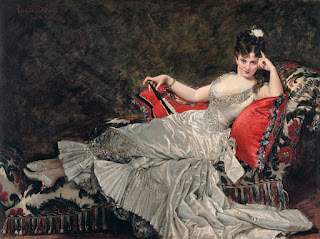Carolus Duran taught that, “In art, all that is not indispensable is unnecessary."
I agree with Carolus, but the word "indispensable" is hard to define in art, and basically amounts to: that which is important to the artist. As such, it is difficult to tell how strictly Carolus adhered to his own principle. Especially in portrait art, an artist is inundated with the particulars of his sitter's personality, and does not necessarily have free reign to paint only that which he cherishes. Nevertheless, Carolus Duran proved canvas after canvas that he was devoted to producing clear, essentialized images.
His student, John Singer Sargent was equally devoted to this idea, particularly in regard to the depiction of tones, which was Duran’s special insight and concern in teaching. Duran taught that: “Objects in nature relieve one against each other by the relative values of light and shade which accompany and are a part of each local color. An outline, a contour, is, as we all know, a pure convention... an accepted convention…”
Both Sargent and Duran valued tonalism, and the accurate depiction of light became to them "indispensable." This aspect of their art can be seen most especially in the many color studies they each made for their masterpieces and the special attention paid in these studies to tonal contrasts. The accurate depiction of the ratios between light and shade was everything to them.
Sargent, Portrait of Carolus Duran (and study for portrait)
Sargent, Portrait of Madame X (and study for portrait)
Duran, Portrait of Madame Ernest Feydeau (and study for portrait)






Comments
Post a Comment